The Shehnai of Bismillah Khan
How the change in fate of a musical instrument, made the best musician of our country:

Pungi was a musical instrument whose sound was shrill and unpleasant, due to which it was banned by Aurangzeb. A barber of a family of professional musicians, modified the pungi, a pipe with a natural hollow stem that was longer and broader.

He played the instrument before royalty and everyone was impressed. The instrument so different from the pungi had to be given a new name. As the story goes, since it was first played in the Shah’s chambers and was played by a nai (barber), the instrument was named the ‘shehnai’.
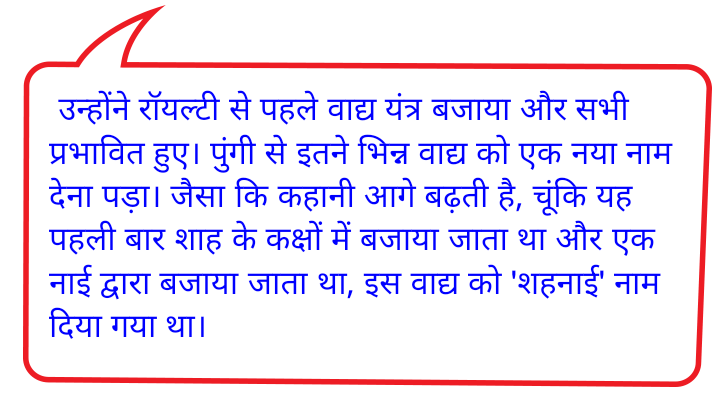
After this Shehnai’s sound was considered auspicious hence it was played in various temples and main sources of music in north Indian weddings. The shehnai was part of the naubat or traditional ensemble of nine instruments found at royal courts.
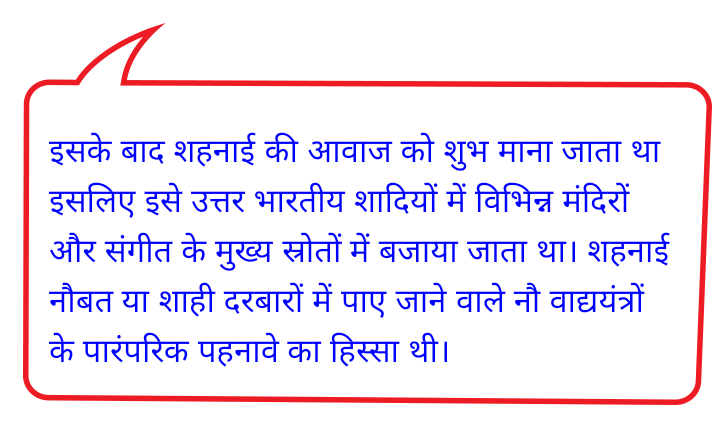
Bismillah Saheb’s birth and family:


Bismillah khan belongs to a well-known family of musicians from Bihar. His grandfather, Rasool Bux Khan, was the shehnai nawaz of the Bhojpur king’s court. His father, Paigambar Bux, and other paternal ancestors were also great shehnai players.


Bismillah saheb’s practices and national performances:

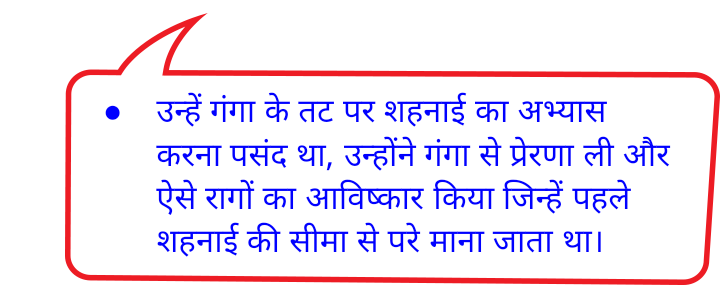
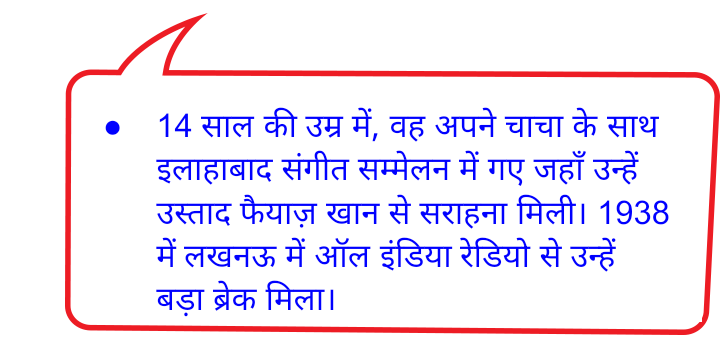


His international performances:


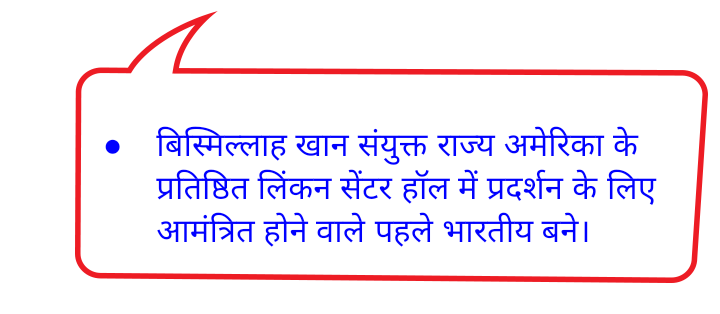

Khansaheb’s awards:



Vijay bhatt kept the name of the film” gunj uthi shehnai “ after listening to him and the movie got a hit. Plus, one of Bismillah Khan’s compositions, “Dil ka khilona hai toot gaya ...,” turned out to be a nationwide chartbuster. Despite this success and popularity in the film industry, he said-''I just can’t come to terms with the artificiality and glamour of the film world”.

He travelled all over the world but didn't want to leave India, especially Banaras and river Ganga. Once he said”“That is why whenever I am in a foreign country, I keep yearning to see Hindustan. While in Mumbai, I think of only Benaras and the holy Ganga. And while in Benaras, I miss the unique mattha of Dumraon.”

Ustad Bismillah Khan’s life is a perfect example of the rich, cultural heritage of India, one that effortlessly accepts that a devout Muslim like him can very naturally play the shehnai every morning at the Kashi Vishwanath temple.
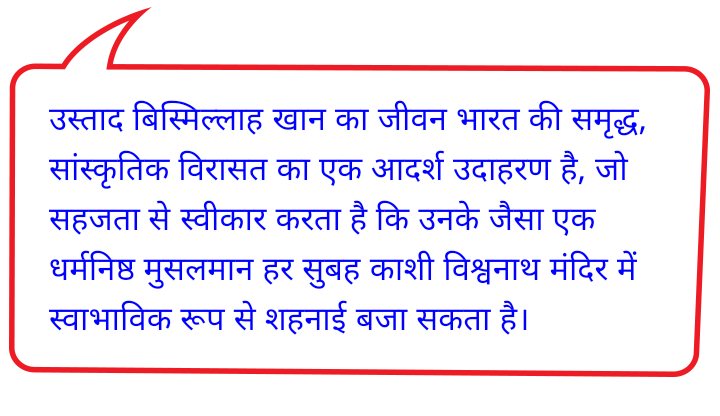
Thinking about the Text I. Tick the right answer.
1. The (shehnai, pungi) was a ‘reeded noisemaker.’
2. (Bismillah Khan, A barber, Ali Bux) transformed the pungi into a shehnai.
3. Bismillah Khan’s paternal ancestors were (barbers, professional musicians).
4. Bismillah Khan learnt to play the shehnai from (Ali Bux, Paigambar Bux, Ustad Faiyaaz Khan).
5. Bismillah Khan’s first trip abroad was to (Afghanistan, U.S.A., Canada).
II. Find the words in the text which show Ustad Bismillah Khan’s feelings about the items listed below. Then mark a tick (✔) in the correct column. Discuss your answers in class.
Bismillah Khan’s feelings about Positive Negative Neutral
1. teaching children music P
2. the film world N
3. migrating to the U.S.A. N
4. playing at temples P
5. getting the Bharat Ratna P
6. the banks of the Ganga P
7. leaving Benaras and Dumraon N
III. Answer these questions in 30–40 words.
1. Why did Aurangzeb ban the playing of the pungi?
Ans. Aurangzeb banned the playing of the pungi in the royal residence for it had a shrill unpleasant sound. Pungi became the generic name for reeded noisemakers.
2. How is a shehnai different from a pungi?
Ans. A barbar family who was a professional musician decided to improve the tonal quality of pungi.He chose a pipe with a natural hollow stem that was longer and broader than the pungi, and made seven holes on the body of the pipe. When he played on it, closing and opening some of these holes, soft and melodious sounds were produced.
3. Where was the shehnai traditionally played? How did Bismillah Khan change this?
Ans. Shehnai played in various temples and main sources of music in north Indian weddings. The shehnai was part of the naubat or traditional ensemble of nine instruments found at royal courts.Bismillah Khan brought this instrument on the classical stage. He invented ragas that were earlier considered to be beyond the range of the shehnai.
4. When and how did Bismillah Khan get his big break?
Ans. Bismillah khan at the age of 14, he went to Allahabad Music Conference with his uncle where he got appreciation from Ustad Faiyaz Khan. He got a big break when the All India Radio in Lucknow in 1938.
5. Where did Bismillah Khan play the shehnai on 15 August 1947? Why was the event historic?
Ans. Bismillah Khan played the shehnai on 15 august 1947 at Red Fort on the occasion of independence. He poured his heart out into Raag Kafi and audiences including Pandit Jawaharlal Nehru
6. Why did Bismillah Khan refuse to start a shehnai school in the U.S.A.?
Ans. Bismillah khan’s love for India wasn’t hidden specially love for banaras and holy river ganga, A student of his in USA told him he would recreate the atmosphere of Benaras by replicating the temples there. But Khansaab asked him if he would be able to transport River Ganga as well.
7. Find at least two instances in the text which tell you that Bismillah Khan loves India and Benaras.
Ans. the two incidences are:
A student of his once wanted him to head a shehnai school in the U.S.A., and the student promised to recreate the atmosphere of Benaras by replicating the temples there. But Khansaab asked him if he would be able to transport River Ganga as well.
Despite huge success in Bollywood for the music, Bismillah Khan’s ventures in film music were limited to two: Vijay Bhatt’s Gunj Uthi Shehnai and Vikram Srinivas’s Kannada venture, Sanadhi Apanna. “I just can’t come to terms with the artificiality and glamour of the film world,” he says with emphasis.While in Mumbai, I think of only Benaras and the holy Ganga. And while in Benaras, I miss the unique mattha of Dumraon.”
I. Look at these sentences.
• Evelyn was determined to live a normal life. •
Evelyn managed to conceal her growing deafness from friends and teachers. The italicised parts answer the questions: “What was Evelyn determined to do?” and “What did Evelyn manage to do?”
They begin with a to-verb (to live, to conceal).
Complete the following sentences. Beginning with a to-verb, try to answer the questions in brackets.
1. The school sports team hopes to win the match they are in. (What does it hope to do?)
2. We all want to be successful in our lives. (What do we all want to do?)
3. They advised the hearing-impaired child’s mother to take him to a hearing expert for treatment. (What did they advise her to do?)
4. The authorities permitted us to organise a fundraiser programme for blind students. (What did the authorities permit us to do?)
5. A musician decided to perform best in his next stage show. (What did the musician decide to do?)
II. From the text on Bismillah Khan, find the words and phrases that match these definitions and write them down. The number of the paragraph where you will find the words/phrases has been given for you in brackets.
1. the home of royal people (1)- the royal residences.
2. the state of being alone (5)- he could practise in solitude
3. a part which is absolutely necessary (2)- indispensable component
4. to do something not done before (5)- invent
5. without much effort (13)- effortlessly
6. quickly and in large quantities (9) - thick and fast.
III. Tick the right answer.
1. When something is revived, it (remains dead/lives again).
2. When a government bans something, it wants it (stopped/started).
3. When something is considered auspicious, (welcome it/avoid it).
4. When we talk about something, we find it (boring/interesting).
5. When you appreciate something, you (find it good and useful/find it of no use).
6. When you replicate something, you do it (for the first time/for the second time).
7. When we come to terms with something, it is (still upsetting/no longer upsetting).
IV. Dictionary work • The sound of the shehnai is auspicious. • The auspicious sound of the shehnai is usually heard at marriages. The adjective auspicious can occur after the verb be as in the first sentence, or before a noun as in the second. But there are some adjectives which can be used after the verb be and not before a noun. For example: • Ustad Faiyaz Khan was overjoyed. We cannot say: *the overjoyed man. Look at these entries from the Oxford Advanced Learner’s Dictionary (2005). awake adj., verb adjective [not before noun] not asleep (especially immediately before or after sleeping): to be half/fully awake; to be wide awake. I was still awake when he came to bed. elder adi., noun adjective 1 [only before noun] (of people, especially two members of the same family) older: my elder brother • his elder sister 2 (the elder) used without a noun immediately after it to show who is the older of two people: the elder of their two sons 3 (the elder) (formal) used before or after sb’s name to show that they are the older of two people who have the same name: the elder Pitt • Pitt, the elder. 2021–22 28 / Beehive Consult your dictionary and complete the following table. The first one has been done for you. adjective only before noun not before noun both before and after the verb be indispensable ✔ impressed afraid outdoor paternal countless priceless
